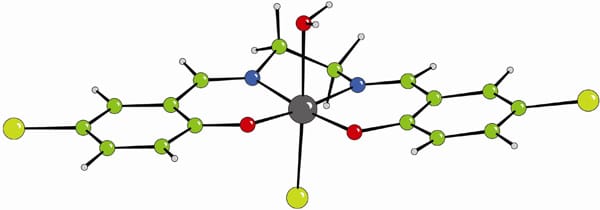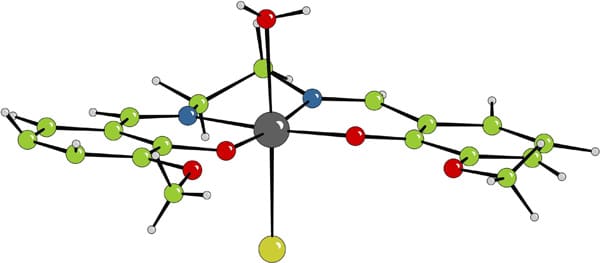Oxidative stress, mediated by reactive oxygen species (ROS), is well recognised to be integral to the disease processes in Alzheimer’s disease.[1-2] The major source of ROS production is the electron transport chain from where electrons leak to react with oxygen to produce ROS. Unregulated, ROS undergo a wide array of reactions with critical biomolecules thus imparting serious structural and functional cell damage. A high prevalence of oxidised fats and proteins has indeed been demonstrated in murine models of AD.[3] The superoxide dismutase–catlase (SOD-CAT) enzyme system is a vital defence against ROS, converting superoxide to water and oxygen.[4] This study investigated the use of SOD-CAT mimetics as novel antioxidant agents to treat AD. A novel SOD-CAT mimetic, NMC-X, was prepared and tested against EUK-134, a known SOD-CAT mimetic. An assay consisting of the agent, an ascorbate probe and the ROS H2O2 was prepared. Antioxidant activity was assessed by comparing the protection afforded by each agent to the ascorbate probe, a molecule highly sensitive to oxidative attack. Both agents were also tested for their stability in water and in the presence of the ROS H2O2. Results revealed intriguing differences in antioxidant properties between EUK-134 and NMC-X. EUK-134 exhibited excellent antioxidant activity over a short 2 hr time period allowing only a 3.1 % oxidation rate of ascorbate. Conversely, NMC-X in fact exhibited pro-oxidant activity over 2 hrs, with the ascorbate having a 64.3 % oxidation rate. Stability testing showed that both agents underwent structural change in a peroxide environment over the 2 hr period that was detrimental to antioxidant activity. The changes appeared to be twofold in nature. There was initial alteration of the oxidation state of each agent that allowed the reduction of ROS to water and oxygen. This was however accompanied by a more gradual change to the agent that accounted for the reduction in antioxidant activity. Further investigation is required to determine the exact nature of this change but it is likely to be due to a non-enzymatic reaction between the agent and the ROS. This research outlines the importance of the structure function relationship in drug development. We describe how the identification of structural features that can reverse antioxidant activity is vital to the increased understanding of the structure-function relationship. Furthermore, our results show that with increased emphasis on improving the stability of the SOD-CAT mimetic class of antioxidant agents, they are well worth pursuing as the next generation of drugs to treat diseases in which ROS play an integral role.
Life Sciences 2007 (2007) Proc Life Sciences, PC411
Poster Communications: Novel antioxidant agents to combat oxidative stress in Alzheimer’s disease
A. Moolla1, G. E. Tranter1
1. Faculty of Medicine, Imperial College, London, United Kingdom.
View other abstracts by:
Figure 1: NMC-X Key: Black: manganese Grey: hydrogen Yellow: chlorine Red: oxygen Blue: nitrogen Green: carbon
Figure 2: EUK-134 Key: Red: oxygen Blue: nitrogen Green: carbon Black: manganese Grey: hydrogen Yellow: chlorine
Where applicable, experiments conform with Society ethical requirements.


